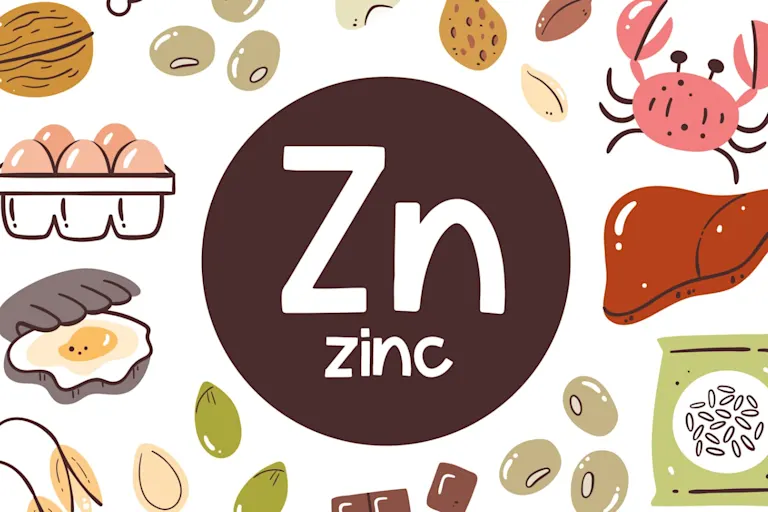Let’s get absorbed in zinc
Written by Ursula Arens

What do we know about the content and bioavailability of zinc in mycoprotein?
In the alphabetical listing of micronutrients, zinc comes last (behind the carotenoid, zeaxanthin). Listing micronutrients by significance to health would be a more challenging task, but in the assessments of typical UK diets, zinc would certainly not be last. It is particularly needed during periods of growth, and for support of the immune system. Deficiency is associated with stunting, diarrhoea, and greater susceptibility to infections.1
How much zinc do we need?
In the UK, dietary reference intakes for adults are slightly higher for men than women (9.5mg / 7mg per day), with additional amounts suggested for women during breastfeeding.2 The National Diet and Nutrition Survey (NDNS) is a government funded continuous assessment of food intakes and nutrient status of the UK population. Data from the survey to 2019 reports average dietary intakes of zinc in UK adults are 8.6mg (men 9.5mg and women 7.6mg), and 7% of adults have inadequate intakes (below the Lower Reference Nutrient Intake).3
What are the best food sources of zinc?
Zinc is a nutrient strongly linked to protein foods. Oysters are extreme zinc providers, containing about ten-fold the amounts of other protein foods per 100g, but (for most people) these would be a ‘never’ or only very occasional food choice, consumed in very small amounts. Most protein foods contain some zinc, and foods, such as some breakfast cereals, may be good sources if they are fortified. The increasing number of individuals choosing to reduce or avoid animal protein foods, has led dietitians and nutritionists to consider the zinc content of both animal and non-animal protein foods, and the bioavailability of this nutrient.
Mycoprotein – as a non-animal protein - is a source of zinc, containing about 7mg per 100g.4 This is less than the levels in chicken breast, but more than in beef burger and some other non-animal protein foods such as chickpeas (see Table 1). Zinc content standardised per 100 kcals of energy, shows mycoprotein containing about 9g, canned chickpeas containing 0.7g, chicken containing 7g and beef containing 2g.
Table 1: Energy and micronutrients of protein foods (per 100g) 5
| Quorn mycoprotein | Chickpeas, canned, drained | Chicken Breast | Beef burger, low fat | |
|---|---|---|---|---|
| Energy (kcals) | ||||
| Calcium (mg) | ||||
| Iron (mg) | ||||
| Magnesium (mg) | ||||
| Zinc (mg) | ||||
| Manganese (mg) |

Absorption rates – more or less?
Nutritionists often consider the bioavailability of a nutrient from a food, in addition to the nutrient content. Some micronutrients are less well absorbed from some foods, because of the presence of other substances in foods that inhibit absorption. The most potent and well described inhibitor of dietary zinc is phytate (phytic acid). This substance is sometimes described as an ‘anti-nutrient’, and is found in seeds, nuts and unprocessed wholegrains (concentrated in the outer bran layer).
Some food production processes reduce the levels of phytate in foods, which results in an increased bioavailability of zinc. Soaking and milling of grains is a familiar process during flour production. Germination of cereals reduces phytic acid by up to 40%. And the most common process of fermentation of grains (such as the addition of yeast to flour during breadmaking), significantly reduces phytic acid content. In contrast, the phytic acid content of ‘unleavened’ breads such as wholemeal pitta breads or flat wraps are high, and so relative absorption of zinc is reduced.1
The ratio of phytate in food relative to zinc content, is a a predictor of zinc absorption rates. Based on measurements from in vivo meal studies, a ratio below 5 links to a high absorption efficiency, corresponding to about 50%. A ratio above 15 links to a low absorption efficiency.6
An assessment of meat substitute products available in Sweden, calculated phytate to zinc molar ratio in mycoproteins to be very low, below 0.5, suggesting that absorption rates of zinc are excellent.7 Another assessment of both animal and non-animal (plant and fungi-based) burgers using in vitro methods (using cultured cell models), demonstrated zinc bioavailability from mycoprotein to be like that of beef, and generally better than other plant burgers.8
Mycoproteins are a reliable source of zinc
The zinc content of mycoproteins is very good, and due to the very low levels of phytates, bioavailability rates match those of animal protein foods. With the consistency of food based dietary guidelines, including the UK Eatwell Guide, supporting some reduction in typical intakes of meat and dairy foods, the greater inclusion of non-animal foods such as plants and mycoprotein, must be assessed in relation to the provision of the vitamins and minerals needed for good health. Zinc provision from mycoprotein seems excellent, both in the amount it contains, and rates of absorption.
About the Author
Ursula Arens has a degree in Dietetics, and has worked in the NHS, in retailing and pharmaceutical research, and at the British Nutrition Foundation. She is currently a monthly columnist with Network Health Digest magazine (read by dietitians and nutritionists) and works as a freelance writer and consultant. She is a member of the sustainable diets interest group of the British Dietetic Association (BDA) and was part of the expert group of the BDA report on environmentally sustainable diets, One Blue Dot.
References:
1 Sangeetha VJ, Sayantani Dutta, Moses JA, Anandharamakrishnan C. Zinc nutrition and human health: Overview and implications (review) e-Food 2022, 3,5. Doi: 10.1002/efd2.17
2 Department of Health. Dietary Reference Values – A guide. 1991, HMSO:London
3 National Diet and Nutrition Survey: Years 9 to 11 of the Rolling Programme (2016/2017 to 2018/2019). Available at: https://www.gov.uk/government/statistics/ndns-results-from-years-9-to-11-2016-to-2017-and-2018-to-2019 [accessed 22 April 2024]
4 Quorn Nutrition, Mycoprotein Micronutrients Profile. Available at: https://www.quornnutrition.com/importance-of-micronutrients
5 Public Health England. McCance and Widdowson’s Composition of Foods. 7th edition 2015. Cambridge, Royal Society of Chemistry
6 WHO Trace elements in human nutrition and health. Geneva: WHO:1996
7 Mayer Labba IC, Steinhausen H, Almius S, Back Knudsen KE, Sandberg AS. Nutritional Composition and Estimated Iron and Zinc Bioavailability of Meat Substitutes Available on the Swedish Market. 2022, Nutrients, 14, 3903
8 Latunde-Dada GO, Kajarabille N, Rose S, Arafsha SM, Kose T, Aslam MF, Hall WL, Sharp PA. Content and Availability of Minerals in Plant-Based Burgers Compared with a Meat Burger. 2023, Nutrients, 15, 2732